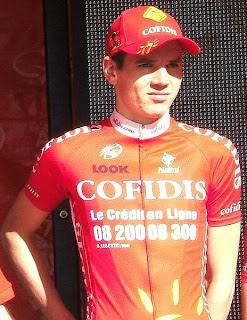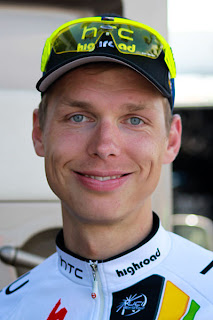 |
| Emile Faingnaert |
The Vuelta a Espana began on this day in 1962, 1967, 1972, 1976 and 1992. Jacques Anquetil had already won two Tours de France and a Giro d'Italia by this point and he entered the 1962 edition, which included 17 stages and covered 2,806km, leaving nobody in any doubt that he was there to become the first man to have won all three Grand Tours. It was generally agreed that he stood a better chance than anyone else of doing so, too; but Fate, being what it is, saw to it that he did not - a gastric condition prevented him from winning any stages and, eventually, caused him to abandon the race. The Saint Raphael-Helyett team remained all but invincibly strong with him out of action and then in his absence; team mates Rudi Altig and Seamus Elliot (the first Irish rider to make an impact on the European cycling circuit and who would tragically commit suicide four years after retiring in 1967) swapped the red jersey (which distinguished the race leader during that period) back and forth between themselves throughout the race. Elliot led for a total of nine stages, but then rode a disastrous Stage 15 time trial that saw him finish overall in third place with a disadvantage of 7'17" behind Altig - the first German to win a Vuelta (the Irish would have to wait more than a quarter of a century for their first win, courtesy of Sean Kelly in 1988).
 |
| Jan Janssen |
1972 once again consisted of 18 stages, two split, the total distance this time being 3,079km. José Manuel Fuente, one of the few riders of the day capable of doing battle and occasionally beating Eddy Merckx (who would not enter the Vuelta until the following year, when he won), won both the General Classification and the King of the Mountains.
In 1976 there were 19 stages, covering 3,340km. José Pesarrodona won, beating Luis Ocaña (who had been Merckx's other main rival) by 1'03", largely on account of a superb Stage 19b time trial where he finished just one second behind stage winner Dietrich Thurau. A Belgian rider, Eric Jacques - then virtually unknown and now virtually forgotten - took a surprise second place in Stage 8, sufficient to put him at the top of the General Classification leadership. Looking at the rest of his career, it comes as somewhat less of a surprise that he failed a doping control after the stage. In those pre-Festina, Puerto and Giro Blitz days the punishments for doping were considerably less than they are today and he received no penalty other than being docked ten minutes; it was, however, enough to ruin his chances and he finished the race in 16th place overall.
 |
| Tony Rominger |
1992 included 20 stages and covered 3,395km. The race was open right from the start after favourites Stephen Roche, Robert Millar, Erik Breukink and Steven Rooks all showed up on noticeably less-than-first-rate form, leaving most people undecided between Tony Rominger and Pedro Delgado - but then Rominger crashed and was left with an injured knee and concussion which caused him to lose three minutes in the Stage 6 time trial. Meanwhile, Breukink had recovered somewhat and won the stage, though with only a slight advantage over surprise second place Jesús Montoya - hitherto known purely as a climber, Montoya's time was sufficient to put him into the overall lead. However, Rominger would also recover fast and, two stages later when the race ventured into France to climb 1,720m Luz Ardiden in the Pyrenees, he dropped all of his rivals one by one - while he would never catch a breakaway led by eventual stage winner Laudelino Cubino and put himself back into contention. Montoya, leading since Stage 6, began to worry after Pedro Delgado was fastest up Lagos de Covadonga to win Stage 13, and from that point on concentrated on beating him; managing to retain the leadership through to Stage 17. The big mistake they both made was in forgetting about Rominger who was working hard to claw his way back up and took a decisive win in the Stage 18 time trial, putting himself into the overall leadership. From that point onwards he was unstoppable and cemented his race victory when he also won the following stage. It would be the first time the Vuelta had ever been won by a Swiss rider and the first step along the way to becoming the first man to win in three consecutive years.
Obree's 1994 Hour Record
 |
| Obree aboard "Old Faithful" (public domain image) |
In fact, Obree's bike - Old Faithful - was very different to the one used by Merckx. For a start, he'd built it himself and it was ridden in an extremely unconventional style. Rather than the drop handlebars used on most track and road bikes, the bars were positioned further back, creating a much shorter distance between them and the saddle (known as "reach"). He would then ride with his upper torso over the bars which he gripped below his chest, thus achieving a streamlined profile similar to that of a skier. The custom bottom bracket was much narrower than standard and elevated chain stays allowed the use of straight cranks, thus permitting him to keep his knees in, and a single-sided streamlined fork reduced the frontal area of the bike. It also featured bearings taken from a washing machine - after noticing that parts in some machines rotate at speeds as high as 1,200rpm, he reasoned that the bearings must therefore be of better quality than those used in bikes. He later regretted telling people this, as the bearings story proved to be of especial appeal to journalists who then ignored the innovation on show on the rest of Old Faithful and wrote silly headlines about a bike made of old washing machine parts.
Old Faithful doesn't look fast at first glance. In fact, it looks a bit like a folding shopper bike (albeit one that somebody's fitted with very expensive carbon fibre wheels) and it wouldn't be unfair to say it's not the most aesthetically-pleasing steed ever to hit the velodrome. Looks can be deceiving - it's very fast indeed and aboard it Obree covered 52.713km in sixty minutes, almost half a kilometre more than previous record holder Chris Boardman. Shortly afterwards, the UCI banned the bike and Obree's riding position.
Today marks the anniversary of the 1979 birth of Scottish professional cyclist James McCallum, who was born in Glasgow and currently rides for Rapha-Condor-Sharp. A natural athlete, McCallum competed in several sports before deciding to concentrate on cycling and, in 2001, became Scottish National Kilo Champion, then British Circuit Race Champion in 2007. Nowadays, he runs Mach 10 - a sports coaching company he set up - and is involved with Champions in Schools, a charity that aims to educate schoolchildren in the benefits of a healthy lifestyle and provide them with access to sport.
Jayme Richardson-Paris is a Paralympian cyclist born in New South Wales on this day in 1989. She began her athletic career as a swimmer but instinctively felt that it was not the sport she would excel in and, after looking around, settled on cycling. This provided her with more difficulties than it does for most people: whilst Jayme was still in the womb, her mother suffered a uterine rupture. After performing an emergency caesarean birth, doctors believed she was dead. Fortunately, both mother and baby survived; but a part of Jayme's brain had been damaged, leaving her with cerebellar ataxia (a condition that makes coordinated movements difficult, leading to "chronic clumsiness"), gross motor retardation and epilepsy. With therapy, her condition improved sufficiently for her to be picked to compete in National events and she began winning races - a lot of races, including twelve in 2011 alone. Her ambition is now to win two gold medals at the 2012 Paralympics in London.
The Basque time trial expert Jonathan Castroviego was born in Getxo on this day in 1987 and joined Euskaltel-Euskadi in 2010 - an unusual choice for the team, as it's traditionally been made up of climbers and specialises in winning gruelling mountain races, but one that paid off the following year when he won the Tour de Romandie after beating Taylor Phinney by 0.27" in the individual time trial. Earlier that year at Tirreno-Adriatico, he had beaten Cadel Evans and David Zabriskie in a time trial - evidence that, as he enters his best years over the coming four seasons, he will emerge as a serious talent.
Other cyclists born on this day: Petra Walczewski (Switzerland, 1968); Roel Paulissen (Belgium, 1976); Riho Suun (USSR, 1960); Santia Tri Kusuma (Indonesia, 1981); Rory Gonsalves (Antigua and Barbuda, 1979); Gianfranco Contri (Italy, 1970); Sergey Tereshchenkov (USSR, 1938, died 2006); Aleksey Kolesov (Kazakhstan, 1984); Harry Steevens (Netherlands, 1945); Gilson Alvaristo (Brazil, died 1956); José Luis Tellez (Mexico, 1938).

























